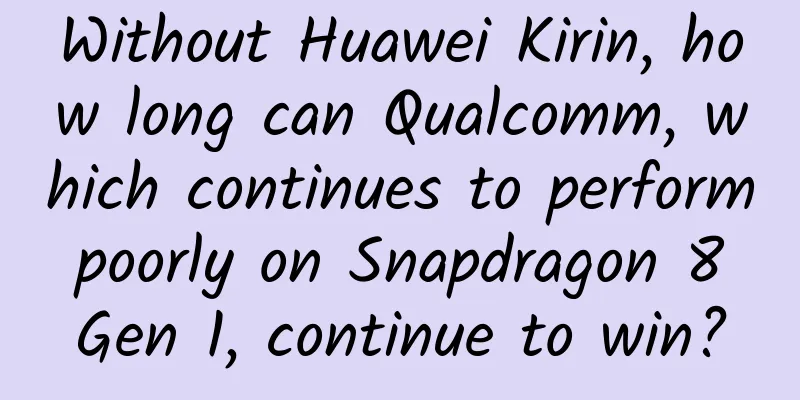Without Huawei Kirin, how long can Qualcomm, which continues to perform poorly on Snapdragon 8 Gen 1, continue to win?

|
Last year, Qualcomm released the flagship SoC Snapdragon 888 for mobile phones, which was a "blockbuster". What surprised people was how much Qualcomm let itself go after losing its strong competitor, Huawei's Kirin chip. According to the test results of many media and evaluation agencies, the performance improvement of Snapdragon 888 compared to the previous generation flagship processor Snapdragon 865 is not obvious, but the power consumption and temperature control have shown a significant decline. In particular, the out-of-control of heat dissipation has earned it the nickname "Fire Dragon 888", and has also made a number of Android flagship phones a must-have hand warmer in winter. Shortly after the release of 888, major mobile phone manufacturers have patched it with "frequency reduction and frame lock". Recently, Qualcomm released its latest flagship mobile processor, Snapdragon 8 Gen 1. The major change in the naming rules seems to indicate Qualcomm's determination to revive the glory of mobile phone chips. Judging from the current evaluation results, the biggest highlight of this Snapdragon 8 Gen 1 is its powerful GPU performance. According to the GPU test conducted by the media Geek Bay, the GPU of Snapdragon 8 Gen 1 even surpassed the "low-power version" A15 processor on the iPhone 13 in some tests. It should be noted that Apple chips have always been known for their significant performance lead, and it is extremely rare for them to be surpassed by competitors' products in tests. It must be said that the significant improvement in Snapdragon 8 Gen 1 GPU performance is indeed eye-catching. But does this mean that Qualcomm has changed its ways after the Snapdragon 888's bad reputation and used its signature skills to create a high-quality product? Unfortunately, it seems that Qualcomm does not intend to let users do as they wish. First of all, in terms of CPU performance, according to the test of Geek Bay, the performance of Snapdragon 8 Gen 1 on Geekbench 5 is very limited compared with Snapdragon 888, and there is no gap with Huawei's Kirin 9000. It is even more cruel when compared with Apple's A series chips. Both single-core and multi-core performance are inferior to the A14 and A15 in the past two years, and the single-core score is even worse than the A13 in 2019. What is even more despairing is the power consumption of Snapdragon 8 Gen 1, which reached 4.2W and 11W in CPU single-core and multi-core tests respectively, which is much better than the 3.8W and 8.9W of Snapdragon 888. In other words, the Snapdragon 8 Gen 1 has a much higher power consumption than the Snapdragon 888 and Kirin 9000, even though its performance has not improved much. The comparison between the Snapdragon 8 Gen 1 and Apple is even more obvious. Although the single-core power consumption of A14 and A15 is much higher than that of the Snapdragon 8 Gen 1, the multi-core power consumption is only 6.7W and 8.6W respectively, which is a perfect victory in terms of energy efficiency. The energy consumption ratio is not optimistic, so heat dissipation naturally becomes a problem. The test results show that when running "Genshin Impact" at the highest picture quality, the body temperature of the Moto Edge X30 equipped with Snapdragon 8 Gen 1 even exceeded 50 degrees. This is a hand warmer in winter and undoubtedly a small nuclear bomb in summer. Even taking into account possible problems such as insufficient initial optimization and the relative lack of technical strength of Motorola under the leadership of Lenovo, such horrific power consumption will surely make all Android phone manufacturers shake their heads - how to suppress this "Yanlong" is probably a problem that they must face in the coming year. After last year's "hot" Snapdragon 888, the outside world's general expectations for Snapdragon 8 Gen 1 have been lowered a lot, but such a "terrible" performance still surprised many people. As soon as the test results of Snapdragon 8 Gen 1 came out, many people believed that this was most likely due to the immaturity of ARM's new architecture and Samsung's new process. In March this year, ARM released a new architecture ARM v9, ten years after the release of the previous generation v8 architecture. V8 is one of the most successful platforms in ARM's history. It has become the basis for smartphones, IoT devices, industrial equipment and some PCs. This makes the public even more looking forward to the new generation of ARM v9. In the technology world, the successors of classic products often perform poorly, such as the iPhone 5 after the iPhone 4S and Windows Vista after Windows XP. Unfortunately, ARM v9 does not seem to be immune. As the focus of this upgrade, the upgrade of the flagship core Cortex-X2 did not meet the expectations of many people. It seems that even ARM itself is a little guilty. In the promotional picture, Cortex-X2+8MB was compared with Cortex-X1+4MB, and the core performance upgrade was highlighted by the Tian Ji horse racing technique. In other words, the Snapdragon 8 Gen 1 based on the ARM v9 architecture is like a seed growing in a less fertile land, and its chances of thriving are inherently lower. At the same time, ARM has only disclosed the theoretical performance of the new architecture. Performance loss is inevitable when Qualcomm designs chips, and there will be another layer of loss when the chips are actually produced. This has led to another person responsible for the Snapdragon 8 Gen 1 "crash" - Samsung. Snapdragon 8 Gen 1 uses Samsung's latest 4nm process, but last year's Snapdragon 888, which used Samsung's 5nm process, had a disastrous power consumption. This year's 4nm process is also an improvement on the 5nm process, so the energy efficiency ratio is naturally limited, and the power consumption explosion is also expected. In addition, the transistor density of Samsung's 4nm process is not as good as TSMC's 5nm, so there is not much performance improvement to be expected. But whether it is ARM or Samsung, they can only be regarded as "accomplices" at most. The real culprit that makes Snapdragon 8 Gen 1 so "squeezed toothpaste" can only be Qualcomm itself, which is not enterprising. We all know that Samsung's technology lags behind TSMC. Why does Qualcomm insist on using it? Is it because Qualcomm can't afford TSMC? MediaTek, whose chip performance and profitability are inferior to Qualcomm, can use TSMC's process, so why can't Qualcomm? The only explanation is that Samsung's offer is lower. Perhaps, it is because Qualcomm knows that after Huawei's Kirin series chips were cut off and MediaTek's Dimensity series performance was slow to improve, it will become the only choice for major Android phone manufacturers in their flagship models. Naturally, it can sit back and choose a lower-cost way to increase its profit margins. Qualcomm today is very reminiscent of Intel, which, after years of being the only company in the computer CPU field, began to stagnate and was mocked as a "toothpaste factory". Its Core 10 and Core 11 series immediately came under unprecedented pressure from AMD's Ryzen series. LinusTechTips, a well-known foreign media, even said, "AMD, please be kind. They (Intel) are already dead. Stop whipping their corpses!" Knowing shame brings courage. Pressure brings motivation. When Apple, a long-time partner, once again "abandoned" Intel, its self-developed M1 series chips shocked the world. Under the background of being attacked from all sides, Intel finally released a big move on this year's Core 12, using double the performance to wipe out the previous shame and re-prove its position as the industry leader. It seems that Qualcomm is going to follow Intel's old path and wait until its competitors are fully developed before making any moves. But the question is, does Qualcomm have the capital to do so? Since Huawei suffered a chip supply cut, most of the market share it gave up has been taken up by Apple. According to Counterpoint statistics, in the first half of this year, Apple has occupied 70% of the high-end market share. From this perspective, it is Apple that has the capital to live off its past success. In fact, the progress of Apple's mobile phone chips in the past two years is indeed not as good as in previous years, but this is mainly because they maintain an absolute lead and have always controlled the energy consumption ratio within a reasonable range. More importantly, Apple is not idle, but has concentrated its efforts in the field of computer processors, digging another moat for its business empire. But what did Qualcomm do? While its mobile phones were so comfortable and unprogressive, how many breakthroughs did it make in other areas? Unfortunately, we don't see many signs of its aggressive progress. Perhaps in the face of Apple's huge advantage, Qualcomm has decided to completely lay low, handing over the high-end market to Apple and focusing on the equally profitable mid-to-high-end market. Of course, this is a successful business strategy, but MediaTek, which is coming from behind, may not agree. You must know that the Dimensity 9000, which has not yet been released but has been leaked, has surpassed the Snapdragon 8 Gen 1 in terms of memory specifications, frequency, core frequency, and number of transistors. Although Kirin has regrettably gone, but in a market environment with Apple in front and MediaTek behind, how long can Qualcomm, which continues to perform poorly, maintain its stable days? As a winner of Toutiao's Qingyun Plan and Baijiahao's Bai+ Plan, the 2019 Baidu Digital Author of the Year, the Baijiahao's Most Popular Author in the Technology Field, the 2019 Sogou Technology and Culture Author, and the 2021 Baijiahao Quarterly Influential Creator, he has won many awards, including the 2013 Sohu Best Industry Media Person, the 2015 China New Media Entrepreneurship Competition Beijing Third Place, the 2015 Guangmang Experience Award, the 2015 China New Media Entrepreneurship Competition Finals Third Place, and the 2018 Baidu Dynamic Annual Powerful Celebrity. |
<<: iPhone 6 teardown analysis shows minimum production cost is $200
>>: Samsung GALAXY Alpha review: metal frame feels great
Recommend
Are the popular plant-based foods just a waste of money or are they really good for your health?
Nowadays, more and more people are beginning to r...
14 super practical and easy-to-use celebrity makeup techniques to make you beautiful and confident_Teacher Shang Tao
Course Catalog: Preliminary lesson: Revealing the...
The industry marketing strategy that took 5 years to compile is given to you!
The home improvement industry is at a turning poi...
What is the most effective way to attract new customers? Take a look at these classic cases!
What is user operation ? User operation is a way ...
iOS WeChat 8.0.14 official version released, adding four new features
The official WeChat team pushed the latest offici...
Subsidy and payment: How do products make the transition from "subsidy" to "payment"?
We found that many newly launched Internet produc...
How can iOS be reliable in recruitment?
I have interviewed many people in the past year. ...
How does Kuaishou attract traffic? Kuaishou’s e-commerce traffic strategy
1. Why is the Kuaishou platform gradually becomin...
What is a human-operated torpedo? It is not remote control, but riding on the torpedo
Torpedoes are an indispensable and important weap...
Gaomi SEO Training: What are the various variations of words in search engines?
What are the various variations of words in searc...
High-tech AI fraud cases increase 50% annually, experts: Don’t believe anything on the screen
Recently, AI fraud cases have occurred frequently...
Hong Raiders Trend Season Hunting Hunting C Intensive Training Camp
Hong Raiders Trend Season Hunting Hunting C Stren...
Summer vacation is coming. How should parents manage their children’s diet and health?
Copyrighted images from the gallery, unauthorized...
China Passenger Car Association: New energy passenger car sales are expected to reach 16.14 million units in February 2025, with a penetration rate of 56%
According to recent news, Cui Dongshu, secretary-...
Baidu promotes the five major marketing values of information flow advertising brand zone!
Establish brand image and enhance brand trust The...









